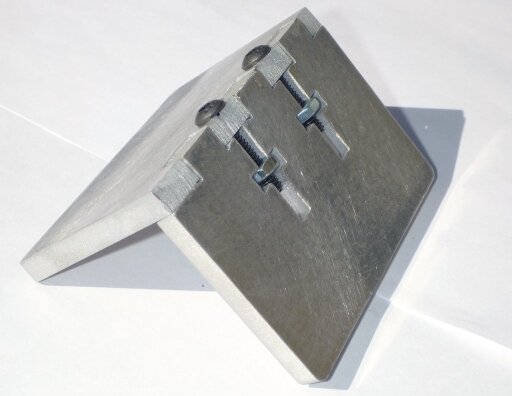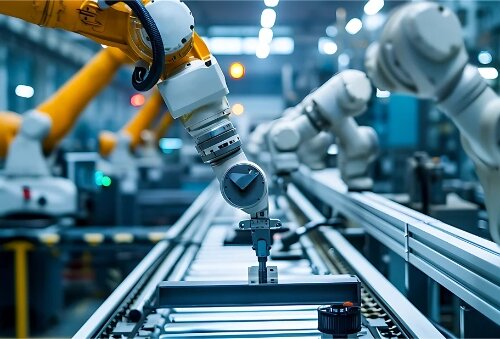Slots and tabs are now one of the most reliable methods for making sheet metal parts fit together. These small interlocking features guide each piece into the correct position. They reduce manual adjustments and help teams maintain steady build quality. When engineers design them well, they shorten assembly time, support smooth workflows, and remove the need for special fixtures.
This article explains why these features are essential and how engineers can design them for real-world production. It brings together shop-floor experience and digital design steps, allowing teams to add slots and tabs with confidence.
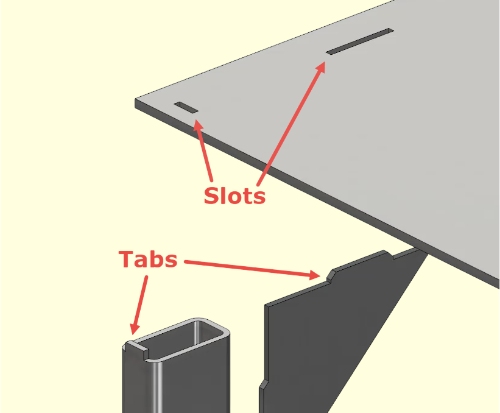
Why Slots and Tabs Matter in Modern Sheet Metal Work?
Slots and tabs shape how fast, accurate, and stable an assembly becomes. The points below illustrate why they have such a significant impact on production workflows.
Self-Fixturing for Faster Assembly
Slots and tabs allow parts to position themselves without heavy use of clamps. This saves time and makes early assembly easier for operators. Many shops see a 30–50% reduction in setup time when they switch from manual alignment to tab-and-slot designs.
Improved Alignment and Repeatability
Tabs serve as simple reference points, preventing parts from shifting or twisting. This helps each unit match the next one. Enclosures, frames, and brackets greatly benefit from this, as better alignment ensures doors fit well and hardware lines up.
Lower Tooling and Fixture Costs
Traditional fixtures take time and money to build. Tabs and slots place the locating function directly in the part. This removes the need for many custom jigs, especially for small or medium batches. This also makes changes easier because the design, not the fixture, handles the alignment.
Better Control During Welding and Joining
Welding produces heat that can cause parts to deform out of shape. Tabs help hold panels steady while the weld cools. This reduces distortion and lowers the amount of grinding and rework needed later.
Core Design Principles for Effective Slots and Tabs
Wise design choices ensure these features fit smoothly and perform reliably. The following guidelines highlight the key dimensions and placement rules to consider.
Choosing Dimensions and Clearances
Clearance refers to the space between a tab and the corresponding slot. القطع بالليزر usually creates a kerf of 0.1–0.2 mm. A good rule is to make the slot 0.1–0.3 mm wider than the tab. Tight fits may bind after لحام or coating. Loose fits may allow parts to shift.
Tab Placement and Quantity Guidelines
More tabs do not always mean better alignment. Too many tabs can make insertion difficult and lead to extra heat in one spot during welding. An 8-inch flange usually needs only three tabs for stable support. One near each end and one in the center gives reasonable control.
Orientation and Geometry Considerations
Tab shapes can help guide the assembly of parts. Engineers often change spacing or shape to prevent wrong assembly. This simple method works well when many similar parts are on the shop floor. Rounded corners or small chamfers also help operators slide tabs into slots more easily.
Managing Tabs Near Bends and Formed Areas
Bending stretches metal and changes nearby geometry. Tabs placed too close to a bend may warp or misalign after the forming process. A safe distance is 2–3 material thicknesses away from the bend area. Engineers should also consider بدل الانحناء و سبرينجباك when a slot is on one part and a tab on another.
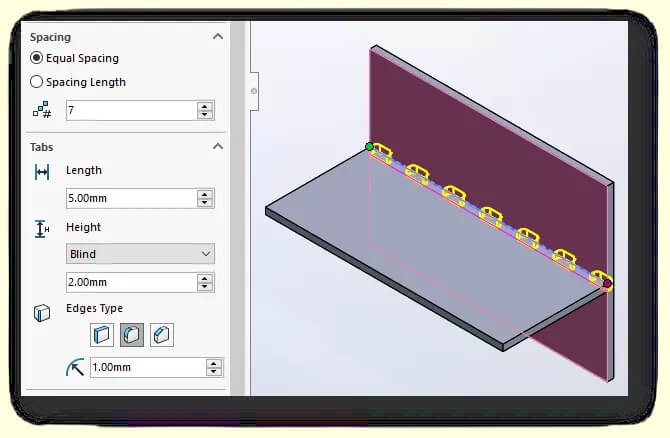
CAD and Digital Design Considerations
Digital modeling significantly impacts how tabs and slots behave during real-world fabrication. The sections below explain the settings and adjustments designers should apply early.
Using Built-In Tab & Slot Features in CAD Software
Modern CAD tools give engineers simple controls for creating tabs and slots. These tools let engineers set the tab length, slot width, spacing, and corner style. The model updates automatically when the design changes, so the features stay consistent. This reduces the need for manual sketches and helps designers avoid common mistakes.
CAD preview tools also show how parts fit before cutting. This helps teams catch alignment issues early and avoid problems on the shop floor.
Accounting for Bending and Forming
Bending changes the shape of metal near the bend line. The bend can stretch or shift the area around a tab or slot. If a tab sits too close to a bend, it may distort or move out of position. A simple rule is to keep tabs 2–3 material thicknesses away from bends.
Engineers also need to think about bend allowance and springback. A small angle change after forming can make the tab harder to insert or cause parts to meet at the wrong point.
Adjustments for Coatings and Finishes
Coatings add thickness to both the tab and the slot. Powder coating can add 60–90 μm per side, while anodizing often adds 10–25 μm. This extra thickness affects fit. If engineers size the slot without considering coatings, the tab may not fit at all after finishing.
Designers can fix this by making the slot slightly wider, masking the area during coating, or assembling the parts before coating. Enclosures often employ the “assemble first, coat later” method to prevent tolerance issues.
Incorporating Error-Proofing into the CAD Model
Tabs do not need to be identical. Engineers often use different shapes or spacings to prevent a part from being assembled incorrectly. This approach keeps production smooth because operators do not waste time fixing orientation mistakes.
Manufacturing Factors That Influence Slot & Tab Performance
Cutting, forming, and welding all change how these features interact. The points that follow break down the main production variables that affect fit and stability.
Laser Cutting, Punching, and Tolerance Behavior
Laser cutting is the most common method for creating slots and tabs. It typically produces a kerf between 0.1 and 0.2 mm in width. Punching may create a slightly tapered edge or introduce different tolerances. These minor differences affect the final fit’s tightness.
Most engineers add 0.1–0.3 mm of extra clearance to the slot to facilitate easier assembly. This keeps the joint stable without making the fit too loose.
Material-Specific Considerations
Each metal reacts differently to cutting, bending, and heat. Mild steel behaves predictably and keeps a stable shape during welding. Stainless steel has more springback, allowing the bends to shift tab positions slightly. Aluminum cuts faster and absorbs heat quickly, which causes a wider kerf. In many cases, aluminum slots need a bit more clearance to avoid binding.
Engineers should adjust the tab length and slot width according to the material to ensure a secure assembly.
Welding Impact and Heat Distortion
Welding creates heat that can cause parts to shift out of position. A well-designed tab-and-slot design distributes the load and minimizes movement during cooling: shorter welds, staggered welds, and balanced tab placement help control distortion.
If the design includes long weld seams, engineers can reduce heat buildup by lowering tab count or adding small relief features. Better heat control means fewer rework instances and more consistent assemblies.
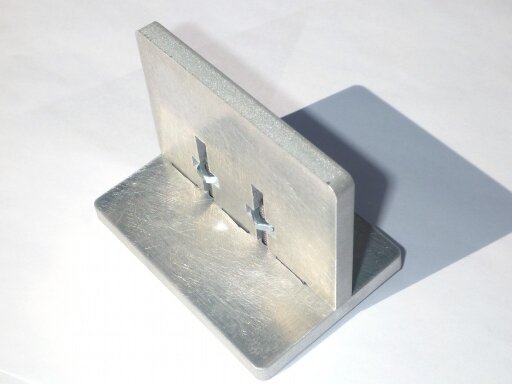
Applications Across Common Sheet Metal Products
Tabs and slots improve assembly across many product types and structures. The sections below outline where they deliver the most significant benefits.
Enclosures and Electrical Cabinets
حاويات utilize multiple panels that must align precisely. Tabs and slots help each wall sit straight before welding or fastening. This keeps doors aligned, hardware centered, and openings square. These benefits make tabs and slots very useful in control boxes, telecom cabinets, and chassis.
Brackets, Frames, and Structural Supports
Frames and support structures need stable geometry. Tabs keep panels from twisting during welding and help the frame hold its shape. This results in stronger and more consistent parts.
High-Volume Production Assemblies
High-volume production values repeatability. Tabs and slots guide parts into place even when new operators join the line. This reduces training time and maintains steady cycle times. Lower error rates and more predictable assembly bring real cost benefits at scale.
Limitations and When Not to Use Tabs & Slots
Some projects require tighter tolerances or cleaner surfaces than tabs allow. The points that follow help you judge when other joining methods work better.
High-Appearance Surfaces
Some products require perfect outside surfaces. Visible tabs may leave minor marks even after sanding and coating. For these parts, engineers often move tabs to hidden areas or use internal alignment ribs.
Ultra-Tight Tolerance Assemblies
Some assemblies need exact fits. If tolerances must be tighter than ±0.1 mm, laser-cut features may not be enough. Machined locating pins or precision fixtures may be more suitable for these cases.
Parts Requiring Frequent Maintenance or Disassembly
Some assemblies must be opened and closed for service. Welded or tight-fitting tabs make disassembly slow and difficult. Systems that need frequent access usually rely on screws, PEM fasteners, or modular brackets instead.
Choosing When to Use Tabs and Slots
Slots and tabs are well-suited for many assemblies, but they may not be the best choice for every project. Engineers need to verify how the parts will be constructed, what the surfaces should look like, and how much tolerance the design allows. These points help engineers make informed decisions early and avoid redesigns later.
Projects with several panels, welded structures, or medium production volumes benefit the most from tab-and-slot designs. Parts with strict cosmetic needs or extremely tight tolerances may require a different joining method.
Deciding If Slots & Tabs Fit Your Project
A structured approach makes the choice clearer and reduces design risk. The steps below walk you through evaluating fit, materials, volume, and finishing needs.
Step 1: Define the Assembly Method
Engineers should first confirm whether the parts will be welded, riveted, or fastened. Welded assemblies gain the most from tabs because tabs help resist heat movement. Riveted or bolted assemblies primarily use alignment tabs, rather than strength.
Step 2: Evaluate Surface and Appearance Requirements
Engineers should check if the part includes visible surfaces. Tabs may leave minor marks after welding and finishing. If the project needs a clean surface, engineers can move the tabs to hidden flanges or internal areas.
Step 3: Consider Coating and Tolerance Stacking
Coatings add thickness and can change the fit between a tab and its slot. Powder coating and anodizing both increase dimensions. Engineers should adjust slot width, plan masking, or assemble parts before coating to avoid interference.
Step 4: Assess Production Volume and Cost Structure
Low- and medium-volume projects benefit from built-in locating features because they reduce the need for fixtures. High-volume programs also gain value because tabs help new operators assemble parts faster. Tabs help maintain steady cycle times and reduce error rates.
Step 5: Confirm Material Behavior Under Cutting and Heat
The type of metal used affects how tabs and slots behave. Stainless steel may shift after bending. Aluminum may need more clearance because the laser kerf is often wider. Engineers should pick clearance values that match the specific material and forming process.
Step 6: Prototype, Test Fit, and Finalize Dimensions
A small prototype helps engineers confirm tab length, slot width, and weld behavior. A test run often reveals minor issues that are easy to fix early. Most adjustments involve slot width, tab length, or weld placement. These small changes can significantly improve the assembly experience.
خاتمة
Slots and tabs provide engineers with a straightforward method to align parts, enhance accuracy, and minimize the need for fixtures. When engineers select the correct clearances, position tabs accurately, and consider coatings and materials, these features are practical across a wide range of product types. They support faster builds, fewer errors, and more consistent results.
If you want to check whether your design is ready for production or you need help fine-tuning the tab-and-slot layout, you can share your drawings with our engineering team. We can review the details, identify potential risks, and suggest improvements that make the assembly process smoother and more consistent.
مهلا، أنا كيفن لي

على مدى السنوات العشر الماضية، كنت منغمسًا في أشكال مختلفة من تصنيع الصفائح المعدنية، وشاركت رؤى رائعة هنا من تجاربي عبر ورش العمل المتنوعة.
ابقى على تواصل

كيفن لي
لدي أكثر من عشر سنوات من الخبرة المهنية في تصنيع الصفائح المعدنية، وتخصصت في القطع بالليزر، والثني، واللحام، وتقنيات معالجة الأسطح. كمدير فني في شنغن، أنا ملتزم بحل تحديات التصنيع المعقدة ودفع الابتكار والجودة في كل مشروع.

